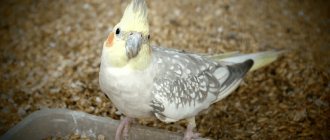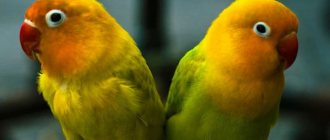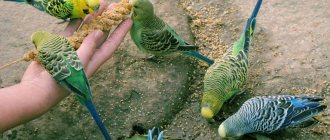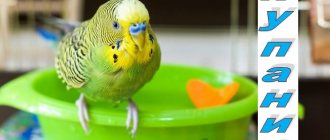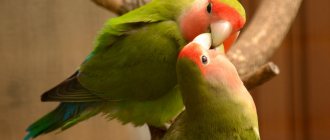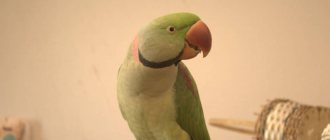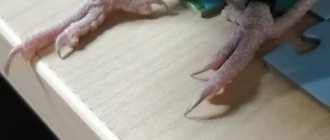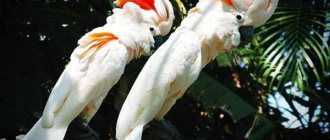Lovebirds: features and characteristics
In nature they live in small flocks of several families. Favorite places are Australian rainforests. It is advisable to be closer to farms, the fields of which can be raided in search of delicacies. The diet includes seeds and berries.
Basic concepts about the lovebird
They spend the night in the trees. Females make nests in hollows and breed offspring. They do not like other birds and defend their territories in fights. This must be kept in mind: it is not recommended to place anyone with lovebirds.
They are less susceptible to learning than other types; they don’t even remember words. But their charm, beauty, mobility, curiosity take their toll. Watching the cute couple is a pleasure.
Features of sleep in natural conditions
The period of active wakefulness of a parrot includes the entire daylight hours - on average it is about 12-14 hours. As soon as night falls, the birds fall asleep. During the day, parrots also sleep a significant amount of time. The fact is that in nature these exotic birds live in conditions of high humidity and air temperature. Therefore, in the middle of the day, when the heat reaches its greatest levels, they hide in deep shade to take a nap. It turns out that parrots sleep at least 10 hours at night and several hours extra during the day. Maintaining just such a routine guarantees the proper development and health of the bird.
Varieties and appearance
Blackwing
This one is from Ethiopia. Not so popular as a pet. Apparently because it is not bright enough. The same greenery predominates, only dark brown wings, not even completely black.
On the forehead of the males there are red narrow rings, a little yellow with a border on the tail - as if the sun was surrounded by soot. Females are completely green.
Black-winged one of the subspecies of lovebird
Rosy-cheeked
A native of southwest Africa, up to eighteen centimeters long, the color of spring savannah grass. The head looks like an orange in cross section: the throat, pink-orange cheeks, red forehead. The tail coverts are blue. The beak is yellow.
Masked
In the wild, it lives in Mozambique, Tanzania, and Zambia. The sizes are slightly smaller than the previous ones, up to sixteen centimeters. The head is black with brown tints.
The neck and chest are yellowish, the throat and sides are dark, and the belly, wings and back are green. The wide rings around the eyes are bare skin. The tail is blue. The beak is red, like a real decoration.
Read also
How to determine the age of a lovebird parrot
Fisher's lovebird
Breeders in Europe already made it this way, and in its native Tanzania it was an ordinary masked one. It acquired a scarlet forehead on a dark green background, a blue rump, and black flight feathers.
Another representative of these parrots is Fischer's lovebird
The white rings of skin around the eyes are preserved, as is the red beak. The color is the same, does not depend on gender, can only be distinguished by size - females are larger.
Red-faced (red-cheeked, orange-cheeked)
This small bird was brought to Europe from Central Africa. It is also found in Western. This species is considered one of the most numerous. Emerald colored parrots.
Girls have an orange mask on their face, and boys have a red one. The beak is the same, very bright. The plumage contains a small amount of blue, black, red, yellow, and brown. Wonderful pestle.
Black-cheeked
The birthplace of this breed is Zambia. It grows up to 16 cm in length, 5 of which are the tail. The green plumage is darker than that of other representatives of the species. The head is thickly orange on top, like coal on the sides, which is where the name comes from.
Black-cheeked lovebird color
The neck is piercingly crimson, there are “glasses” of narrow strips of bare skin. In captivity, this species reproduces better than its distant relatives.
Liliana's lovebird
They are also called strawberryheads. The smallest of the masked parrots. Scarlet forehead, the same sides and throat, but with a tinge of yellow. It really looks like a berry. The rings on the eye sockets are wide. Against the overall dark green background, this is very impressive. Screams shrilly in flight. The color is the same and does not depend on gender. It is difficult to buy, since exporting them from the continent is prohibited.
Grey-headed
Lives in Madagascar, Mauritius, Comoros. A small birdie - up to fourteen centimeters. Here the green shade is complemented by pearl gray on the chest, neck and head. The color below is yellowish. Wide tail and small beak. Females are simply green. In captivity they are shy and refuse to reproduce.
Grey-headed lovebird subspecies
Green-headed (collared)
They bring it from Central Africa, if you can catch it. This happens rarely, therefore it is almost never found in the cage. The birds are very beautiful in appearance, but they fly quickly, while screaming loudly and disgustingly.
They also run fast. The rest of the time they sit high, choosing trees twenty to thirty meters high. It is difficult to keep them at home.
The black-billed and black-necked miracle has an orange necklace of indescribable beauty, for which it received another name - the necklace lovebird. Blue appears closer to the tail, and black appears on the flight feathers.
Natural habitats
Depending on the species, lovebirds inhabit the forests of the tropics and subtropics; some species prefer mountainous areas and steppe plains.
Geographically, lovebirds live in the southeast, southwest and central Africa, and to be more precise:
- collared - in central Africa and the southwest of the continent;
- masked - in Kenya and on the east African coast in Tanzania;
- red-faced - in Ethiopia, Tanzania, Sao Tome, Sierra Leone;
- rosy-cheeked - in South Africa, Namibia and Angola;
- black-cheeked - in the southwest of Zambia;
- black-winged - in Ethiopian forests and mountains, as well as in northeast Africa;
- grey-headed - on the islands of Madagascar, Zanzibar, Mauritius, in the Seychelles in palm and date plantations;
- Liliana's lovebirds - in the eastern district of Zambia, southern Tanzania and northern Mozambique;
- Fisher's lovebirds - in northern Tanzania.
Character and behavioral characteristics
They always stay close to people and are not afraid at all. Main characteristics of birds:
- unpretentious;
- active;
- mobile;
- friendly;
- flexible.
Many advantages. There is only one drawback - the voice is too loud and unpleasant. However, they rarely bother with screams, almost never for no reason. The owners will have to get up early. This parrot is a good replacement for a rooster. But you can create an artificial night by darkening the bird’s home, then awakening will be delayed.
Is it possible to separate birds?
It is forbidden. They have difficulty coping with the loss of their soul mate, given by nature itself, and can become fatally ill. It is a sin to destroy such unions!
Consequences of parrot separation
Intellectual abilities
If you keep him alone, he will gradually learn to copy individual words during training. Curious. Willingly studies the human world: sounds, objects. Intelligence is rated as high.
Memory is good: easily finds a cage, responds to a name. Amenable to training. With a couple of lovebirds everything is different. They have no time for us, they have love.
Lifespan
They live for about fifteen years and are faithful to each other until death. In captivity, a bird's eyelid depends entirely on the quality of care.
Sleep patterns when living at home
Being in captivity, a pet often cannot navigate the daylight hours; the peculiarities of the Russian climate are also very different from the native conditions of the bird. Therefore, the owner’s task is to create artificial conditions close to the natural regime. Understanding how much parrots usually sleep in the wild will help normalize your pet's routine.
A significant part of a parrot's sleep occurs at night, and usually owners go to bed later and get up earlier than their pets. Therefore, it is recommended to cover the cage with a thick fabric cape at night - this way you can turn on the light without disturbing the bird. It is better not to use heavy synthetic fabrics - it is important to ensure sufficient air flow so that the pet does not suffocate.
You need to calculate the number of hours of sleep according to the time of year. In summer, parrots are more active and energetic, they need less time to regain strength - sleep can be about 10 hours a day. In winter, the metabolism slows down, the bird needs longer rest, about 14 hours. During daytime sleep, it is also better to cover the cage so that the pet is not disturbed.
Parrot selection
This species can live in flocks, pairs and alone. If the future owner wants only one bird, it is advisable to prefer one born in captivity and already domesticated.
How to choose a parrot
In other cases, she will yearn for communication. You need to choose a couple from one representative at a time from different breeders, so that no excesses occur in the offspring due to family ties.
Possible sleep disorders
Just as there are two types of wakefulness among people, pets can be divided into two categories: owls and larks. Some individuals enter the host mode: they go to bed after 23:00 with the end of sleep at 11:00. Parrots falling asleep early (before sunset) portends trouble; at 5-6 o'clock in the morning the bird will be full of energy and restless chirping will begin to be heard from under the covers asking to be “fed.”
The cause of lack of sleep in parrots can be the painful symptoms that the bird experiences:
- Lethargy, painful condition.
- Unintended shedding.
- Aggression.
- Loss or deterioration of appetite.
Floor
If you plan to keep a pair, you still buy a male first. When he gets used to it, you can choose a girl who will immediately be placed in his cage.
If you do it differently and place a boy with an already tamed female, they are unlikely to be able to become friends, because birds have a matriarchy. Females will spread rot and knock the guest. They can even maim and kill. They are much stronger and larger than males.
Which gender is preferable?
Health and behavior
Not a single living creature is immune from disease. You need to carefully watch how the little birds behave, then the first symptoms of the disease will not escape the watchful eye.
The first aid kit should always contain special medications and care products:
- Activated carbon;
- chamomile;
- three percent hydrogen peroxide;
- Vaseline oil;
- 1.2 ml syringes;
- cotton buds;
- cotton pads;
- tsamax;
- 60 watt lamp.
Birds get sick for various reasons. If normal care is provided, a comfortable regime is maintained, household members are careful not to bring infection, the parrots will always calmly show off to the delight of observers.
Basic concepts of caring for a lovebird
With any ailment, their behavior changes. The appetite disappears, they become silent, sit for a long time at the bottom of the cage, and become tufted. Why could this be?
- Infection from the street.
- Lack of certain vitamins.
- Poor nutrition.
- No movement.
Any of the above risks requires a visit to the veterinarian, since laboratory testing of droppings and blood is necessary to make an accurate diagnosis and prescribe treatment.
Read also
Reproduction of budgerigars at home for beginners
Whether it is a regular moult or a French moult, poisoning or parasites, a cold or vitamin deficiency - it is difficult to determine on your own.
Moreover, cure it.
Diseases and prevention
Parrots, like all other birds, are susceptible to various diseases. Most often birds get sick:
- obesity and rickets;
- hypovitaminosis or vitamin deficiency;
- coccidiosis;
- worms and feather eaters;
- knemidocoptic mange (scabies, gamas and scabies mites);
- psittacosis;
- salmonellosis;
- aspergillosis;
- excessive shedding;
- Newcastle disease, manifested by fever, lack of appetite and difficulty breathing;
- Eschechiriosis due to intestinal colibacteria;
- atypical avian plague;
- parasitic effect of roundworms;
- trichomoniasis;
- tumorous;
- one-sided paralysis;
- benign and malignant tumors;
- impaired feather growth;
- French molt;
- goiter inflammation;
- gout, rhinitis, laryngotracheitis, bronchopneumonia;
- constipation and diarrhea;
- self-plucking, scabies and plucking;
- namin and hyperkeratosis.
In addition, they can be poisoned by low-quality food, get injured, and become aggressive. This is also important to remember for a person keeping lovebirds.
Disease prevention will be:
- Constant disinfection of the cage with all equipment using a solution of formaldehyde with bleach.
- Regular varied and balanced diet.
- Keeping the lovebird in constant motion to avoid obesity and rickets.
- Systematic inspection of the cage for the integrity of the things in it to avoid possible injury.
- Periodically trim claws or beaks using sharp scissors.
- Disinfection of a cage using sodium solution and creolin after the death of a parrot.
Thus, if you put into practice what is written above, your feathered friend will live a long and happy life. Proper maintenance and care of masked parrots, rosy-cheeked parrots, Fisher's lovebirds and others is possible only if these rules are followed. Take care of your winged friend. Then he will be happy and will delight you, your family members and your guests.
What is needed to keep parrots
This breed is considered quite easy to care for. However, some rules must be strictly followed. This is especially important for beginning breeders.
Necessary for keeping a lovebird parrot
Cell
You need to choose a house for your pet that is as spacious as possible. Apartments usually have little space, but the minimum parameters should still be as follows: 80x30x40 centimeters for a single person and 100x40x50 for two. They need to be given the opportunity to fly, at least for a couple of wing flaps.
Material – metal. This is the best option. No designer jewelry needed. A better square or rectangular home for birds has not yet been invented.
The rods must be horizontal so that you can climb on them. The retractable bottom is more convenient so as not to disturb the birds during the cleaning process. At the bottom there is sand or paper, but not newspaper.
Feeders
Two containers will be needed for food and one for a drinking bowl. Dishes should always be clean and should be washed daily.
Feeders for parrots
Baths
They also come complete with a cage. The birds are small and do not require large tanks. They love to swim and are very funny at these moments. Many pamper them by spraying them with a spray bottle.
Additional accessories
The best toys are considered natural, those that can be eaten: vegetables, pieces of wood with bark, pine cones, bunches of grapes - whatever. Good stationary ones are bells and swings. You should not clutter your home, as this will impede the free movement of birds.
Choosing the right place
Birds are curious, so they need to have a good view. Let them watch the pets and everything that happens in the room. If you place the house at eye level, mutual communication will become more accessible.
Illumination
The room should be very light, but without direct sunlight. This is the main principle of cell arrangement. In the dark season, short daylight hours can be extended using a special lamp.
It is better to place a cage with a lovebird in a well-lit place
Temperature
Below twenty degrees is an alarming indicator on the thermometer. For natives of African latitudes, such a temperature regime can be disastrous. Optimally, twenty-five, then forever lovers feel great. But placing their housing near heating appliances is strictly prohibited.
Drafts
Protection from drafts must be complete. They are destructive to birds.
How should a parrot sleep?
Owners often worry about the health of their new pets. If a parrot is lethargic and sleepy most of the day, sitting with a ruffled face, the reasons can be very different. In the first days in a new place, the bird experiences severe stress, so a large amount of sleep is normal. This will help your pet recover from the shock. But if there are no visible improvements within three to five days, you should pay closer attention to the health of the parrot.
If a bird sleeps with its feathers ruffled and hides its head under its wing, it is trying to raise its body temperature. Signs that your pet is freezing cannot be ignored. Unsuitable temperature conditions can lead to a serious cold, so it is better to immediately move the bird to a warmer room and install a heater or lamp.
Sometimes parrots can sleep with their eyes open - this is not a sign of illness. Under natural conditions, lowering the eyelids helps birds protect themselves from bright light during the afternoon siesta. But at night the light does not interfere and they often leave their eyelids raised, this also helps to notice the approach of a predator in time. Therefore, if a pet sleeps with its eyes open, this only means that the room is in comfortable twilight.
Read in this article
Lovebirds are small, agile parrots. Bird lovers appreciate them for their bright colors and interesting behavior. Lovebirds quickly get used to people and are easy to keep.
How to care for your pet
Attention from the owner must be constant. At first, the birds are afraid of new acquaintances, shy away from hands and sit in their cage forever. This is temporary.
If there is a lot of emotional involvement in the new family member, the parrot will make contact sooner and will stop hiding in a corner when people appear. Doors must always be open.
Subsequently, the birds will freely stretch their wings, flying around the room, which is very useful and helps to avoid many diseases.
How to properly care for a parrot
Proper diet: what you can and cannot eat
Grain mixtures are the basis of nutrition, but there is one caveat. Wavy food is not suitable for a pair of lovebirds. Need food for medium parrots. The grain must be sifted. In addition to the base, various additives are required:
- vegetables (carrots, cauliflower, broccoli, radishes, turnips and the like);
- fruits (bananas, peaches, kiwi, cherries, apricots, plums, tangerines (all pitted);
- rowan, cucumbers, peanuts, walnuts.
It is very useful to give oats and millet sprouted. In our latitudes, tropical residents adore the dandelion leaf.
The daily intake of food is two to three teaspoons for each person.
You should not offer parrots lemon slices, although the water is enriched with a couple of drops of juice to prevent infections. For them, bird cherry is a potent poison; the seeds contain hydrocyanic acid. This dose does not harm people, but kills birds.
What to feed a lovebird
Cleaning the cage
In the morning or evening, you need to wash the tray, feeders and drinkers with a sponge under hot water without chemical detergents. Once a week, wash the entire bottom, wipe the poles, rods, and toys with a damp cloth.
Every month you need to disinfect everything with a decoction of calendula or chamomile, you can use a weak solution of manganese. This helps get rid of germs, bacteria, even parasites.
Read also
How to wash a parrot's cage
Bathing
Bathing is a great pleasure for lovebirds. You need a suitable bath, otherwise they will dive into the drinking bowl and into any other containers in which they find liquid.
Bird games and training
Parrots are more likely to learn to pronounce sounds from a child or woman with a high-pitched voice. To do this, devote ten minutes to exercise every day before feeding. The thin voice is mesmerizing.
Lovebirds. Determination of gender. Maintenance, breeding.
The lesson should be more like a normal conversation; you shouldn’t get angry and stubbornly demand anything. The parrot will not immediately repeat the whole phrase. You need to start with individual sounds and short words.
You should always fill what is said with emotion and try to maintain intonation. Many people use a voice recorder and other aids. However, communication with a living person is much more pleasant for birds and brings more results.
Vaccination
The vaccination is almost always combined, capable of eliminating rabies, adenovirus, psittacosis, parainfluenza virus, and sometimes leptospirosis.
It is given once, then on a schedule every three or four weeks until a certain age. Before six months of age, it is mandatory to be vaccinated against rabies.
Pets.Rosy-cheeked lovebird
Diseases and prevention
Basically, lovebirds rarely get sick because they are removed from the outside world. However, it happens. Diseases can be divided into three classes:
- Non-contagious (injuries, vitamin deficiency, obesity, improper molting, problems with egg laying, swelling of the joints, etc.).
- Parasitic diseases affecting the food tract, skin, eyes, paws, beak, down and feathers. They are caused by helminths and various mites.
- Contagious when you urgently need to stop contact with relatives.
Read also
Diseases of lovebirds and their symptoms
In any case, an ornithologist is needed immediately as soon as the first symptoms are noticed. Prevention requires only careful care, proper diet and hygiene.
Sleep and rest
Birds sleep at least ten hours every day, and in winter, up to fourteen. They fall asleep at dusk. Therefore, in the summer you can create the onset of night artificially, thus helping the birds to rest. Sometimes during the day they settle down on their perch, legs tucked under, to take a nap. There is no need to interfere with them, there is also nothing to worry about.
Lovebirds - All about the breed of parrots | Parrot breed - Lovebird
Feeding lovebirds
The diet of lovebirds, like other small parrots, is based on seeds and grain. The amount of food required per day for one adult is 2 - 4 tablespoons. The composition of ready-made mixtures from different manufacturers includes various ingredients:
- millet;
- canary seed;
- cereals;
- ground corn;
- whole or crushed oats;
- dried fruits;
- nuts;
- sunflower seeds.
Industrial products contain a complex of vitamins that a parrot needs. Additional feeding with vitamins and minerals is required only in those months when the lovebird is molting or preparing to breed. In addition to dry plant food, the parrot must receive animal protein (cottage cheese, boiled eggs), as well as raw fruits and vegetables.
Mango, papaya and avocado should not be given to lovebirds. These fruits are rich in essential oils that irritate the digestive system of birds.
You can properly organize feeding using several feeders. Grain mixtures are poured into one container in the evening, the entire daily requirement at once. Wet food is placed in another feeder in the morning and changed during the day as needed, and all residues are removed at night.
Breeding
Not everyone agrees to reproduce. Black-cheeked and pink-cheeked need special conditions, which are difficult to fulfill. Mating games begin in the spring. It's time to attach the nest.
How to determine gender
It is very difficult to determine the sex, except by size, and these are very dubious signs. The most accurate method is DNA analysis.
Courtship and pregnancy
For normal offspring, parents need to be energetic, active and healthy. They can hatch eggs up to four times a year, but this will physically exhaust the parrots. It is better to take control of all bird initiative.
The optimal period is considered to be from February to May. It is difficult to care for chicks in winter and summer: heat is bad, cold is even worse. Experienced breeders choose late spring or very early autumn.
Breeding lovebirds
Laying eggs
If the couple is satisfied with the nest box, she will independently equip a place in it that is somewhat similar to a mitten. You can start incubation. Lovebirds incubate the eggs alternately. You can’t disturb them, much less touch the eggs with your hands.
Sleeping positions
To fall asleep soundly, birds do not take long to find a comfortable position. A few familiar poses for sound sleep:
- On two legs. They sit down on both legs, sitting on a branch. This position is occupied by old individuals or patients whose nervous system is damaged and coordination of movements is impaired. When they try to lift their legs, they fall out of place.
- On one leg. During sleep, the birds tuck one paw under themselves, alternate them, and close their eyes. For insurance, the parrot rests its tail on twigs or a feeder.
- When afraid, the birds climb to the highest point of the cage and sleep right under the roof. In this situation they feel safe.
- With the head thrown back to the side, no matter how remarkable, this is the favorite pose of birds.
- They hide their head under their wings when they feel cold. The wing plays the role of a blanket, and breathing makes the air warm, thus the birds restore heat exchange in the body.

